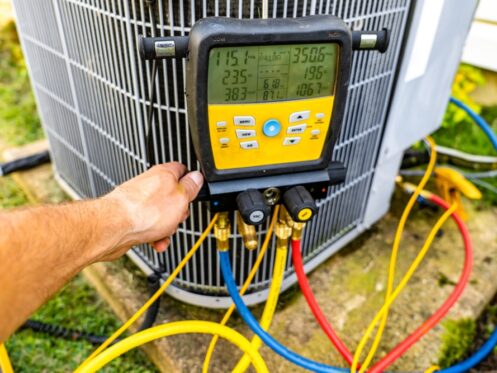If your AC sounds and looks like it’s on, but you don’t feel any cooler, it might not just be in your head. Various issues, whether clogged air filters or failing fans, can cause your AC to run but not actually cool your home. Learn how certain components may derail your AC’s precise operations and prevent properly cooling or distributing air, and when to call High 5 in Denver for professional AC repair.
Thermostat Settings
Your thermostat functions as the control center for your cooling system by signaling the AC’s control board to activate the compressor and blower fan according to temperature readings and settings. Incorrect thermostat settings are a common reason ACs may be working but not cooling. Check that the thermostat is set to cool rather than fan or heat. Test the system by setting the thermostat at least 3 degrees cooler than the current room temperature — if it doesn’t kick on, your thermostat may be faulty.
Thermostats can malfunction if the internal software glitches, the temperature sensor is miscalibrated, or damaged. For example, the thermostat might mistakenly read the indoor temperature at 72 degrees while the room is actually 78 degrees. Since it thinks your home is cooler than it is, the thermostat won’t prompt a cooling cycle. Thermostats may also become unresponsive if the batteries are dead, the electrical connections are loose or damaged.
Air Filter
The air filter filters dust, dander, and other airborne particles as they enter the ductwork system to improve air quality and protect the evaporator coil and blower from dust buildup. AC filters require replacing every 1 to 3 months, depending on usage and indoor air quality. When the air filter becomes clogged, it restricts airflow entering your system and flowing across the evaporator coil.
Air must flow freely across the evaporator coil, which houses part of the refrigerant loop, to maintain an efficient heat exchange process. When a clogged filter restricts this airflow, the refrigerant becomes too cold and may cause condensation to freeze over the evaporator coil. Frozen coils further reduce the system’s ability to condition incoming air. Eventually, the blower may overheat or the system may shut down from the strain of trying to keep up with cooling demand.
Refrigerant Levels
Refrigerant is a chemical compound that cycles between liquid and gas to transfer heat. It absorbs heat in the evaporator coil from incoming warm air, then travels to the outdoor unit to expel the heat and condense. This system relies on specific refrigerant quantities and pressure levels to maintain efficiency.
Low refrigerant levels lower the pressure inside the evaporator coil and prevent it from absorbing heat properly. Ice may also form and insulate the coil, further inhibiting conditioning, all while the compressor continues to operate.
Since refrigerant circulates in a closed-loop system and is meant to last the lifetime of your AC system, low refrigerant typically indicates a leak. A technician can usually repair leaks from corrosion or damaged parts and recharge the refrigerant to restore regular operation.
Condenser Unit
The outdoor condenser unit houses the compressor, condenser coil, and condenser fan motor. These components coordinate to receive refrigerant from the indoor unit, expel heat, and compress the refrigerant for recirculation. If the condenser unit can’t expel heat properly, the system may run but struggle to lower indoor temperatures. Several issues can impact the condenser unit’s performance:
- Dirty or damaged condenser coils: Like evaporator coils, condenser coils can’t complete the heat exchange process if they’re damaged or insulated by dirt or dust.
- Burnt-out condenser fan motor: The fan draws air over the coil to help release heat. If it fails, heat won’t dissipate properly and may cause system overheating.
- Blocked airflow around the condenser: Branches, grass, dirt, and other debris around the unit can trap heat.
Air Ducts and Vents
Air ducts and vents circulate air throughout your AC equipment and indoor area, and proper airflow relies on a sealed and balanced system. Leaks or disconnections in the ductwork allow 20% to 30% of cooled air to escape before it reaches your living space. The AC may continue to operate but deliver less air to rooms and fail to reach the set temperature. These efficiency losses also force your system to work significantly harder, resulting in components that wear out more quickly and high energy bills.
Obstructed or closed supply or return vents can also disrupt pressure balances in your ductwork system. If return ducts are undersized or partially blocked, the blower may struggle to pull sufficient air across the evaporator coil and limit cooling power.
Electrical Issues
AC systems have a network of electrical components that signal and regulate cooling operations. If even one of these components fails, your AC may blow air without actually cooling your home.
For example, capacitors provide a voltage boost for the compressor and fan motor. A malfunctioning capacitor prevents these components from receiving the power they need to start or run, so the system may hum or click, but won’t cool. Contactors are electrical switches that control the electrical flow to various components. If a contactor is pitted or burnt, it may only allow an inconsistent electrical contact and underpower the associated component.
The AC control board is the system’s logic controller for interpreting thermostat signals and activating the appropriate relays. If the board malfunctions, whether from surges, water damage, or age, it may fail to deliver consistent power to various AC components.
Having Issues With Your Home’s AC Unit? Contact the HVAC Professionals at High 5
If your air conditioner is running but your home isn’t cooling down, rely on a professional for expert support. Contact us today — call the team at High 5 and discover why we’re a leading HVAC contractor in Denver. Our team is standing by, ready to help you, and we offer all the HVAC services you need in one place.

